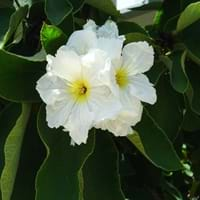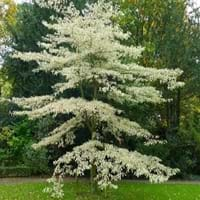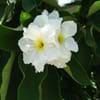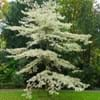Life Span
Perennial
Perennial
Origin
Southwestern United States, Texas, Mexico
India, Nepal, China, Japan, Korea
Types
Not Available
Not Available
Habitat
Well Drained
Woodland Garden Canopy
USDA Hardiness Zone
8-11
5-8
Sunset Zone
H1, H2, 8, 9, 10, 11, 12, 13, 14, 15, 16, 17, 18, 19, 20, 21, 22, 23, 24
Not Available
Habit
Oval or Rounded
Upright/Erect
Flower Color
White, Yellow, Ivory
White, Ivory
Flower Color Modifier
Bicolor
Bicolor
Fruit Color
Black
Burgundy, Dark Blue, Black
Leaf Color in Spring
Gray Green, Dark Green
Green
Leaf Color in Summer
Gray Green, Dark Green
Green, Dark Green
Leaf Color in Fall
Gray Green, Dark Green
Light Yellow, Burgundy, Dark Red
Leaf Color in Winter
Olive, Gray Green
Not Available
Leaf Shape
Elliptic
Ovate
Plant Season
Spring, Summer, Fall
Spring, Summer, Fall
Sunlight
Full Sun
Full Sun, Partial Sun
Type of Soil
Loam, Sand
Clay, Loam
The pH of Soil
Acidic, Neutral, Alkaline
Acidic, Neutral
Soil Drainage
Well drained
Well drained
Bloom Time
Late Spring, Early Summer, Summer, Late Summer, Fall, Late Fall, Early Winter
Late Spring, Early Summer
Tolerances
Drought, Salt, Soil Compaction
Not Available
Where to Plant?
Ground
Ground
How to Plant?
Budding, Seedlings
Grafting, Seedlings
Plant Maintenance
Medium
Medium
Watering Requirements
Average Water Needs, Do not water frequently, Prefer drip-irrigation instead of Over-head watering
Requires regular watering during dry weather
In Summer
Lots of watering
Lots of watering
In Spring
Moderate
Moderate
In Winter
Average Water
Average Water
Soil pH
Acidic, Neutral, Alkaline
Acidic, Neutral
Soil Type
Loam, Sand
Clay, Loam
Soil Drainage Capacity
Well drained
Well drained
Sun Exposure
Full Sun
Full Sun, Partial Sun
Pruning
Remove damaged leaves, Remove dead branches, Remove dead leaves
No pruning needed
Fertilizers
All-Purpose Liquid Fertilizer, Apply N-P-K, Phosphorous
No fertilizers needed
Pests and Diseases
Pests and diseases free, Red blotch
Bacterial leaf spot, Canker, Powdery mildew
Plant Tolerance
Drought, Dry Conditions
Drought
Flower Petal Number
Single
Single
Fragrant Flower
No
Not Available
Showy Bark
No
Not Available
Foliage Texture
Coarse
Coarse
Foliage Sheen
Matte
Matte
Attracts
Birds, Hummingbirds, Butterflies
Birds
Allergy
Pollen
Not Available
Aesthetic Uses
Borders, Cottage Garden, Used in parkland
Used in parkland
Beauty Benefits
Not Available
No Beauty Benefits
Environmental Uses
Air purification
Air purification
Medicinal Uses
Cough, Rheumatism
Antiphlogistic
Part of Plant Used
Flowers, Fruits, Leaves
Fruits, Leaves
Other Uses
Used as Ornamental plant
Oil used in the lubricating and soap industry
Used As Indoor Plant
No
No
Used As Outdoor Plant
Yes
Yes
Garden Design
Feature Plant, Mixed Border, Rock Garden / Wall, Shade Trees, Tropical
Shade Trees, Street Trees
Botanical Name
CORDIA boissieri
CORNUS controversa
Common Name
Anacahuita, Texas Olive
Giant Dogwood, Wedding Cake Tree
In Hindi
Anacahuita
Wedding Cake Tree
In German
Anacahuita
Hochzeitstorte Baum
In French
anacahuita
Gâteau de mariage Arbre
In Spanish
anacahuita
Pastel de bodas del árbol
In Greek
Anacahuita
Γαμήλια τούρτα Δέντρο
In Portuguese
Anacahuita
Árvore do bolo de casamento
In Polish
Anacahuita
Wedding Cake Drzewo
In Latin
Anacahuita
MUSTACEUM ligno
Phylum
Tracheophyta
Magnoliophyta
Class
Magnoliopsida
Magnoliopsida
Order
Boraginales
Cornales
Family
Boraginaceae
Cornaceae
Clade
Angiosperms, Asterids, Eudicots
Angiosperms, Asterids, Eudicots
Tribe
Not Available
Not Available
Subfamily
Not Available
Cornoideae
Number of Species
Not Available
Difference Between Anacahuita and Wedding Cake Tree
If you are confused whether Anacahuita or Wedding Cake Tree are same, here are some features about those plants to help you choose better. Many people think that these two plants have the same characteristics, but one can see Anacahuita and Wedding Cake Tree Information and learn more about it. Fertilizers required for proper growth of Anacahuita are All-Purpose Liquid Fertilizer, Apply N-P-K and Phosphorous, whereas for Wedding Cake Tree fertilizers required are No fertilizers needed. Hence, one should know the basic difference between Anacahuita and Wedding Cake Tree if you are planning to have them in your garden to enhance its beauty.
<
Flowering PlantsImportance of Anacahuita and Wedding Cake Tree
Want to have the most appropriate plant for your garden? You might want to know the importance of Anacahuita and Wedding Cake Tree. Basically, these two plants vary in many aspects. Compare Anacahuita and Wedding Cake Tree as they differ in many characteristics such as their life, care, benefits, facts, etc. Every gardener must at least have the slightest clue about the plants he wants to plant in his garden. Compare their benefits, which differ in many ways like facts and uses. The medicinal use of Anacahuita is Cough and Rheumatism whereas of Wedding Cake Tree is Antiphlogistic. Anacahuita has beauty benefits as follows: Not Available while Wedding Cake Tree has beauty benefits as follows: Not Available.
Compare Facts of Anacahuita vs Wedding Cake Tree
How to choose the best garden plant for your garden depending upon its facts? Here garden plant comparison will help you to solve this query. Compare the facts of Anacahuita vs Wedding Cake Tree and know which one to choose. As garden plants have benefits and other uses, allergy is also a major drawback of plants for some people. Allergic reactions of Anacahuita are Pollen whereas of Wedding Cake Tree have Not Available respectively. Having a fruit bearing plant in your garden can be a plus point of your garden. Anacahuita has no showy fruits and Wedding Cake Tree has showy fruits. Also Anacahuita is not flowering and Wedding Cake Tree is not flowering . You can compare Anacahuita and Wedding Cake Tree facts and facts of other plants too.





